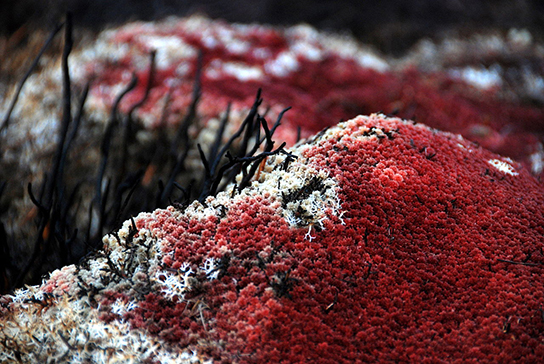| << Chapter < Page | Chapter >> Page > |
Mosses and liverworts are often the first macroscopic organisms to colonize an area, both in a primary succession—where bare land is settled for the first time by living organisms—or in a secondary succession, where soil remains intact after a catastrophic event wipes out many existing species. Their spores are carried by the wind, birds, or insects. Once mosses and liverworts are established, they provide food and shelter for other species. In a hostile environment, like the tundra where the soil is frozen, bryophytes grow well because they do not have roots and can dry and rehydrate rapidly once water is again available. Mosses are at the base of the food chain in the tundra biome. Many species—from small insects to musk oxen and reindeer—depend on mosses for food. In turn, predators feed on the herbivores, which are the primary consumers. Some reports indicate that bryophytes make the soil more amenable to colonization by other plants. Because they establish symbiotic relationships with nitrogen-fixing cyanobacteria, mosses replenish the soil with nitrogen.
At the end of the nineteenth century, scientists observed that lichens and mosses were becoming increasingly rare in urban and suburban areas. Since bryophytes have neither a root system for absorption of water and nutrients, nor a cuticle layer that protects them from desiccation, pollutants in rainwater readily penetrate their tissues; they absorb moisture and nutrients through their entire exposed surfaces. Therefore, pollutants dissolved in rainwater penetrate plant tissues readily and have a larger impact on mosses than on other plants. The disappearance of mosses can be considered a bioindicator for the level of pollution in the environment.
Ferns contribute to the environment by promoting the weathering of rock, accelerating the formation of topsoil, and slowing down erosion by spreading rhizomes in the soil. The water ferns of the genus Azolla harbor nitrogen-fixing cyanobacteria and restore this important nutrient to aquatic habitats.
Seedless plants have historically played a role in human life through uses as tools, fuel, and medicine. Dried peat moss , Sphagnum , is commonly used as fuel in some parts of Europe and is considered a renewable resource. Sphagnum bogs ( [link] ) are cultivated with cranberry and blueberry bushes. The ability of Sphagnum to hold moisture makes the moss a common soil conditioner. Florists use blocks of Sphagnum to maintain moisture for floral arrangements.

The attractive fronds of ferns make them a favorite ornamental plant. Because they thrive in low light, they are well suited as house plants. More importantly, fiddleheads are a traditional spring food of Native Americans in the Pacific Northwest, and are popular as a side dish in French cuisine. The licorice fern, Polypodium glycyrrhiza, is part of the diet of the Pacific Northwest coastal tribes, owing in part to the sweetness of its rhizomes. It has a faint licorice taste and serves as a sweetener. The rhizome also figures in the pharmacopeia of Native Americans for its medicinal properties and is used as a remedy for sore throat.

Go to this website to learn how to identify fern species based upon their fiddleheads.
By far the greatest impact of seedless vascular plants on human life, however, comes from their extinct progenitors. The tall club mosses, horsetails, and tree-like ferns that flourished in the swampy forests of the Carboniferous period gave rise to large deposits of coal throughout the world. Coal provided an abundant source of energy during the Industrial Revolution, which had tremendous consequences on human societies, including rapid technological progress and growth of large cities, as well as the degradation of the environment. Coal is still a prime source of energy and also a major contributor to global warming.
Vascular systems consist of xylem tissue, which transports water and minerals, and phloem tissue, which transports sugars and proteins. With the development of the vascular system, there appeared leaves to act as large photosynthetic organs, and roots to access water from the ground. Small uncomplicated leaves are microphylls. Large leaves with vein patterns are megaphylls. Modified leaves that bear sporangia are sporophylls. Some sporophylls are arranged in cone structures called strobili.
The seedless vascular plants include club mosses, which are the most primitive; whisk ferns, which lost leaves and roots by reductive evolution; and horsetails and ferns. Ferns are the most advanced group of seedless vascular plants. They are distinguished by large leaves called fronds and small sporangia-containing structures called sori, which are found on the underside of the fronds.
Mosses play an essential role in the balance of the ecosystems; they are pioneering species that colonize bare or devastated environments and make it possible for a succession to occur. They contribute to the enrichment of the soil and provide shelter and nutrients for animals in hostile environments. Mosses and ferns can be used as fuels and serve culinary, medical, and decorative purposes.
[link] Which of the following statements about the fern life cycle is false?
[link] D.

Notification Switch
Would you like to follow the 'Biology' conversation and receive update notifications?